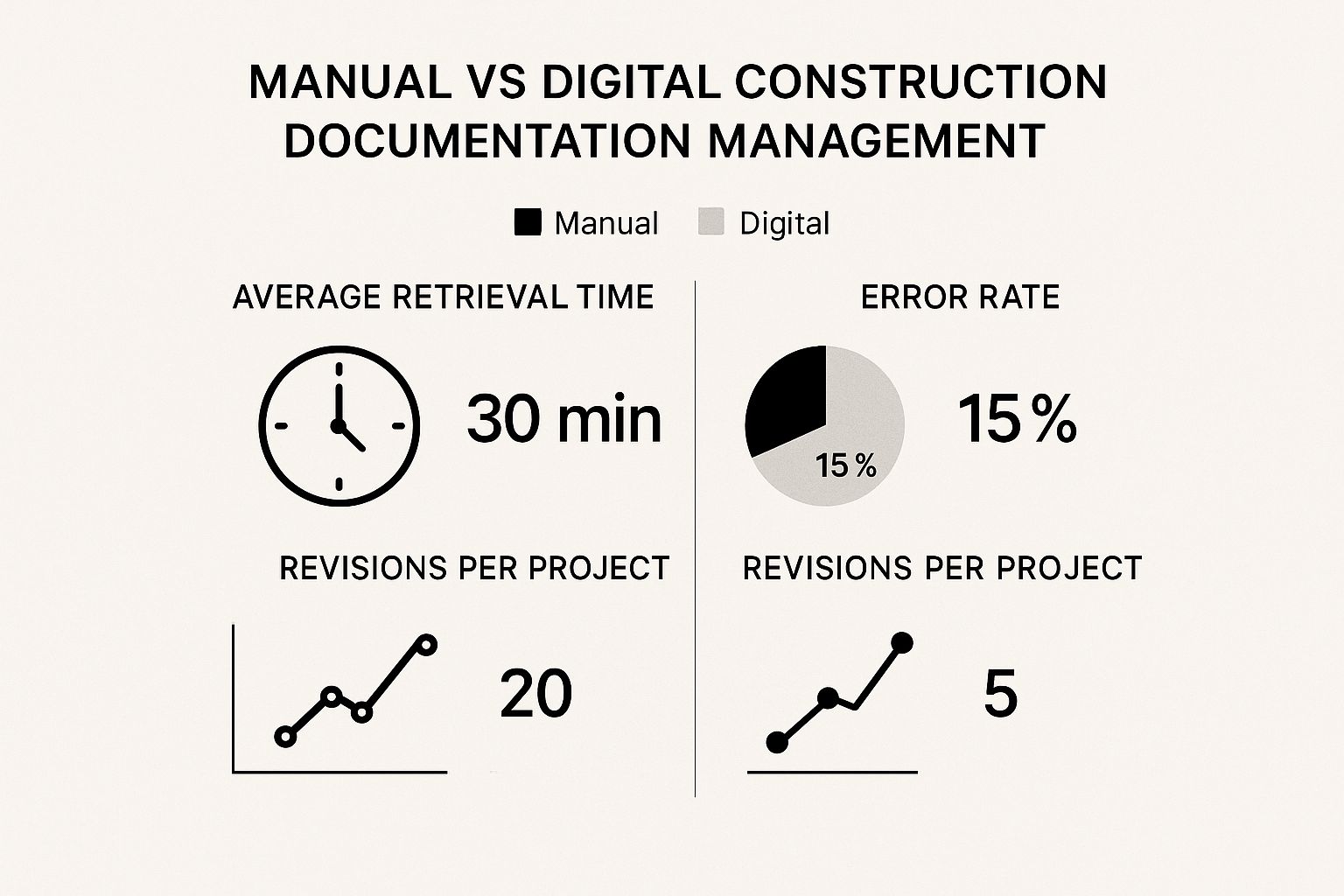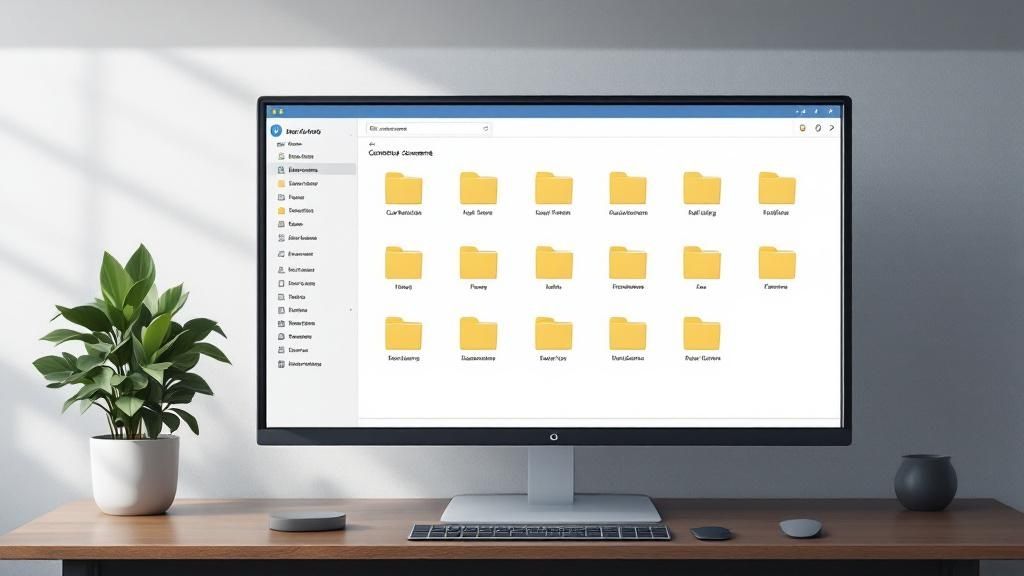Construction documentation management isn't just about filing paperwork. It's the disciplined process of organizing, sharing, and archiving every single document a project generates—from the first sketch to the final warranty. Think of it as the project's central command, guiding every action and decision from groundbreaking to handover.
Get it right, and you prevent costly rework. Get it wrong, and you're looking at a cascade of delays, disputes, and blown budgets.
Why Documentation Is Your Project's Central Nervous System
It’s easy to dismiss documentation as a glorified digital filing cabinet, but that’s a mistake. In reality, it’s the active, beating heart of your entire project. It's the blueprint, the collective memory, and the communication network all rolled into one, governing every move made on-site and in the office.
A solid system ensures every piece of information—from architectural drawings to RFIs—is accurate, current, and accessible to everyone who needs it. When the architects, engineers, subcontractors, and clients are all working from the same playbook, confusion evaporates. It creates a single source of truth that synchronizes efforts and fosters genuine accountability.
The True Cost of Disorganization
Let's be blunt: mismanaging these vital records is a direct path to project failure. When documents get lost, people work off outdated versions, or critical information is inaccessible, the consequences ripple through the timeline and the budget. Just imagine a subcontractor framing walls based on a blueprint that was revised two days ago. That's not just a mistake; it's a significant financial hit and a schedule delay you can't afford.
The core principle here is proactive control, not reactive filing. The goal isn't to scramble and find a document after a mistake has been made. It's to build a system that guarantees information integrity from day one, preventing those problems from ever happening.
This mindset shifts documentation from a passive administrative chore into an active risk-management strategy.
The Shift from Paper Piles to Smart Platforms
The days of lugging around giant rolls of blueprints and sorting through chaotic email chains are numbered, and for good reason. The industry's move toward digital systems is happening fast because the benefits are too significant to ignore.

As the numbers show, going digital drastically cuts down on administrative friction and minimizes the risk of expensive errors. This isn't just a trend; it's a fundamental change in how construction gets done. The global market for document management systems (DMS) is booming, with construction firms driving a 16.1% compound annual growth rate as they integrate these tools with their core project management software. For a deeper dive, you can explore more insights on the document management market.
The table below breaks down just how much has changed.
Traditional vs Modern Construction Documentation Management
This comparison shows the evolution from paper-based methods to digital, AI-driven systems and their impact on key project areas.
The takeaway is clear. Modern systems create a clean, auditable trail for every change order, RFI, and submittal. This not only keeps the project on track but also provides critical legal protection by demonstrating compliance and recording every decision.
Ultimately, a strong documentation workflow is the foundation of a successful, profitable, and far less stressful construction project.
The Building Blocks of an Effective Document System
To get a handle on your project documents, you need to understand the core parts of a solid management system. Think of these as the foundation, walls, and roof of your information house. Each part supports the others, and if one is weak, the whole structure is at risk. Get them right, and you’ll keep project information flowing smoothly instead of causing chaos.

These key components are what direct the right information to the right people at exactly the right time. Let’s break down the three non-negotiable pillars: version control, approval workflows, and access controls. Each one solves a critical, high-stakes problem that pops up on every single job site.
Pillar 1: Version Control
Picture this: your crew is on site, meticulously framing a wall based on a set of blueprints. The problem? The architect sent over an updated drawing yesterday, and your team is working off the old one. Every bit of work they're doing is now a candidate for expensive rework. This is exactly the kind of disaster version control prevents.
It’s arguably the most critical function of any document system. Version control is all about making sure that every single person, whether they’re in the trailer or in the home office, is looking at the most current set of documents. The system automatically sidelines old drafts and pushes the latest one to the forefront, taking the guesswork out of the equation.
A project without real version control is just a project running on luck. You're essentially guaranteeing that, at some point, someone will build from an outdated plan, leading to rework that can blow up budgets and schedules.
This isn't just for blueprints, either. It’s crucial for any document that changes over time:
- Contracts and all their addendums.
- Schedules that get tweaked weekly, if not daily.
- Submittals that go back and forth for review.
- Change orders that formally alter the scope of work.
Without a system handling this automatically, you’re stuck with file names like "Final_Plan_v3_USE_THIS_ONE.pdf"—a recipe for confusion and costly mistakes.
Pillar 2: Approval Workflows
The second pillar, document approval workflows, sets up a clear, digital chain of command for information. It’s like a sign-off sheet that can’t be lost, moves at the speed of a click, and keeps everyone honest. It automates the process of getting documents in front of the right eyes for review and sign-off.
For example, when a trade partner submits an RFI (Request for Information), a pre-set workflow can fire it off to the project manager instantly. After their review, it automatically routes to the architect for the final say. Every single step is tracked, timestamped, and logged.
This creates an airtight audit trail. If a dispute pops up six months down the road, you can pull up the record and see exactly who approved what, when they did it, and any notes they left. This level of accountability is gold for resolving conflicts and protecting your company from liability. In fact, a study from the Project Management Institute noted that poor communication contributes to 56% of project failures—a risk that these structured workflows directly tackle.
Pillar 3: Access Control
Let’s be honest: not everyone on a project needs to see every single file. The plumbing sub doesn’t need to pore over the prime contract’s financials, and the electricians don't need the landscape drawings. That's where access control becomes essential.
This feature lets you create specific permissions, ensuring that people can only view, edit, or approve the files that are relevant to their job. It's both a practical security measure and a way to declutter everyone's workspace.
By giving your field teams access to just the plans and permits they need, you make their lives easier and help them find what they’re looking for fast. At the same time, you can lock down sensitive information like:
- Financial records and detailed budgets
- Legal contracts and other agreements
- Human resources documents
Properly set up, access control is the final piece of the puzzle. It makes sure your perfectly organized, version-controlled library is also secure and efficient for every single user.
How Poor Documentation Sinks Construction Projects

A well-run project moves forward on the back of clear, accessible information. But when construction documentation management falls apart, it’s not just a minor headache. It's the start of a domino effect that can completely torpedo a project's budget, schedule, and reputation.
Think of it like this: a construction project is a complex machine with thousands of interacting parts. Poor documentation is the sand you throw in the gears. It creates friction, grinds progress to a halt, and can lead to total system failure. This isn’t just a metaphor; it’s the daily grind for teams stuck with outdated, paper-based, or disorganized digital methods.
One of the classic ways things go wrong is the information silo. This is when different teams are working from different realities. The architects update a crucial structural drawing on their server, but the crew on-site is still building off an old printed set. For two days, nobody notices. The result? A wall in the wrong place that has to be torn down and rebuilt, costing thousands in rework and delaying every trade that was supposed to come after.
The Ripple Effect of One Small Mistake
Let’s walk through how a single documentation fumble can spiral. It often starts small, like with a Request for Information (RFI) from a subcontractor. He emails it to the project manager, who’s buried in other tasks and just forwards it to the architect without logging it anywhere. The architect replies with the answer, but that email gets lost in the PM’s inbox.
Weeks go by. The subcontractor, having never received a formal answer, finally makes an educated guess to keep things moving. That guess ends up causing a clash with the HVAC system that’s being installed a month later. Work stops. The project is now bleeding money every single day that crews stand around waiting for a fix. The finger-pointing starts.
The real cost isn’t just the rework. It’s the breakdown of trust, the soul-crushing "blame game" meetings, and the complete loss of momentum. A messy paper trail leaves you with no defense, no clear record of who knew what and when.
This single scenario pulls the curtain back on several all-too-common failures:
- No Single Source of Truth: Information is scattered across emails, personal hard drives, and different software. It’s impossible to track what's current.
- Manual Data Entry Goofs: A simple typo on a purchase order can mean the wrong grade of steel or incorrect window sizes show up on site, bringing everything to a standstill.
- Gaps in Compliance Records: A missing inspection sign-off or a misplaced safety log can get a project shut down by an auditor or lead to massive fines.
The Staggering Price of Inefficiency
Disorganization has a real price tag. One study found that construction professionals spend over five hours a week just searching for project data. That’s five hours they aren’t building, problem-solving, or managing their teams—it's just wasted time. On a medium-sized job, that lost productivity easily adds up to tens of thousands of dollars over the project's life.
And that’s before we even talk about legal exposure. When a dispute ends up in court or arbitration, the side with the clean, complete, and time-stamped records almost always wins. If your documentation is a mess, you have no way to defend your actions or hold others accountable.
Ultimately, ignoring proper construction documentation isn't just a bad habit—it’s a massive business risk. It turns solvable problems into project-killing disasters. A solid system isn't a "nice-to-have"; it’s fundamental to your survival and profitability in this industry.
Proven Best Practices for Seamless Document Workflows
Alright, enough about the problems. Let’s talk about solutions. The good news is that you don't need a complex, theoretical framework to fix a chaotic workflow. A handful of practical, field-tested best practices can turn that information mess into a smooth, reliable engine for your project.
These aren't just abstract ideas; they are the core strategies successful firms use every day. The goal is to build a system where finding the right document is second nature, information is always current, and your project data is locked down and auditable. Getting your construction documentation management right is the bedrock of finishing on time and on budget.
Establish a Single Source of Truth
This is the most important step you can take. Period. You need to create one central, official place for all project documents to live—what we call a "single source of truth." When you do this, you immediately kill the most dangerous question on a job site: "Is this the latest version?"
This hub should be cloud-based, giving your team—from the site superintendent to the office-based project manager—access to the same information, no matter where they are. It shatters the information silos that build up when crucial files are trapped on someone's laptop, buried in an email chain, or saved on a random server. When the architect, the GC, and the subcontractor are all pulling from the same library, you get consistency. You get clarity.
A single source of truth isn't just a fancy digital folder; it's a commitment to reality. It means when a decision is made or a plan changes, there is only one place to find that new truth. This alone prevents a huge amount of expensive rework that happens when crews build off outdated plans.
Implement Standardized Naming Conventions
Once you have a central hub, you have to keep it organized. Otherwise, you’ve just created a digital junk drawer. This is where standardized naming conventions come in. Without a clear system, your shiny new repository will quickly devolve into a mess of files named "Final_Plans_v2_REVISED_use_this_one.pdf." We’ve all seen it.
A logical naming system means anyone on the team can find what they need in seconds, without having to ask. A simple, effective structure uses key identifiers to give context at a glance.
Example Naming Structure:[ProjectNumber]-[Discipline]-[DocumentType]-[Description]-[Version]
So, a real-world file name might look like this:24-015-ARC-DWG-L2_Floorplan-v3.pdf
Instantly, you know:
- Project Number: 24-015
- Discipline: Architectural (ARC)
- Document Type: Drawing (DWG)
- Description: Level 2 Floorplan
- Version: 3
This simple discipline saves an incredible amount of time over the life of a project. No more frantic searching.
Define Clear Roles and Permissions
Not everyone on the job needs access to every single file. A well-run system uses role-based access to make sure information is both secure and relevant. Your plumbing sub needs the latest mechanical plans, but they don’t need to see the electrical schematics or, more importantly, sensitive financial contracts.
This does two critical things:
- It boosts security. You protect confidential data like bids, change orders, and payroll from ending up in the wrong hands.
- It makes people more efficient. Team members only see the documents they need. It clears out the clutter and helps them find information fast.
As the industry rightly moves away from paper, this level of control becomes even more critical. Modern document management systems don’t just store files; they help automate indexing, retrieval, and compliance tracking, taking the administrative burden off your team. This digital shift slashes paper consumption, cuts the massive cost of physical storage, and seriously reduces a firm's carbon footprint. You can learn more about how this is changing the game for businesses on Docsvault.com.
Conduct Regular Audits
Finally, remember that your system isn't a "set it and forget it" tool. You have to perform regular audits to keep it healthy. Think of it as preventative maintenance for your project's data. These checks ensure everyone is actually following the processes you put in place, like your naming conventions and approval workflows.
Audits help you catch bad habits before they spread and create chaos. They’re also absolutely essential for compliance, giving you a scheduled chance to confirm that all permits, inspection reports, and safety logs are filed correctly and are easy to find. For a deeper look at managing your project information effectively, check out these 10 essential data management best practices.
How AI Is Upgrading Construction Documentation

The future of construction documentation management is already here, and it’s powered by Artificial Intelligence. This isn't some far-off theory; it’s about practical tools you can use right now to solve the industry’s most stubborn headaches. AI has moved beyond a simple buzzword to become a genuine workhorse, automating mind-numbing tasks and delivering insights that were once out of reach.
Think of your document library as a massive, chaotic warehouse. For years, finding a single box—a specific clause or drawing—meant a slow, manual search. AI is like a super-powered robotic assistant that not only knows where every box is but also understands what’s inside. This jump from manual searching to intelligent discovery is fundamentally changing how projects get done.
Intelligent Search and Information Retrieval
The most immediate impact AI has is on search. Standard search tools are fine if you know the exact file name. But what if you need to find every single mention of "ASTM A36 steel specifications" scattered across thousands of submittals, RFIs, and contracts from the last six months?
That’s where AI-powered search comes in. It uses Natural Language Processing (NLP) to understand the context and intent of your query, not just the keywords. It can pinpoint a specific clause buried in a 300-page contract or find every drawing related to the second-floor HVAC system, even if the file names are a mess. This is a game-changer, cutting down information retrieval time from hours to seconds.
AI transforms your document repository from a static archive into a dynamic, searchable knowledge base. It gives your team the power to ask complex questions and get instant, accurate answers, turning data into actionable intelligence on the spot.
Automated Tagging and Classification
One of the biggest bottlenecks in any document system is the manual effort needed to keep it organized. Every new file—a site photo, a delivery receipt, a revised blueprint—has to be named correctly, filed in the right folder, and tagged with the right info. It's tedious, time-consuming, and a recipe for human error.
AI automates this entire process. An AI system can look at a new document, figure out what it is (e.g., "RFI," "Change Order," "Daily Report"), pull out key information like dates and project numbers, and then automatically file and tag it based on your company's rules.
For example, a photo from the job site can be automatically tagged with the project name, date, GPS location, and even use object recognition to identify that it's related to the "electrical rough-in." The result? A perfectly organized library with zero manual effort, ensuring consistency and making future searches even more powerful.
Generative AI and Copilots
Going beyond simple organization, generative AI is now stepping in as a "copilot" for project managers and admins. These AI assistants are built right into the platforms you already use, helping teams draft and process information faster than ever before.
Here’s how it works in the real world:
- Drafting Communications: An AI copilot can generate a standard RFI response or a daily progress summary based on just a few simple prompts.
- Summarizing Reports: You can feed the AI a long, dense site inspection report, and it will spit out a concise, bulleted summary of the key findings and action items in seconds.
- Analyzing Field Notes: A technician can send a series of voice notes, and the AI will transcribe, organize, and format them into a clean, professional daily log.
This kind of automation is quickly becoming a necessity. A stunning 77% of businesses are now adopting document management software more quickly, with 26% boosting their investment in automation specifically. AI tools are leading the charge, hitting search precision rates above 95% and using generative copilots to slash manual work and human error. You can explore more about how businesses are using these document management statistics to drive efficiency.
These tools don’t replace human expertise; they amplify it, freeing up your skilled people to focus on critical thinking and problem-solving instead of getting buried in paperwork.
Your Questions on Documentation Management Answered
Jumping into a new system, or even just trying to fix an old one, is bound to bring up some questions. To help you get a handle on construction documentation management, I’ve pulled together some of the most common things people ask, along with some straightforward, practical answers. The goal here is to clear up any confusion so you can move forward with confidence.
Let's get right to it.
What Is the Single Biggest Benefit?
If I had to pick just one, it’s creating a "single source of truth." This idea is the bedrock of modern project management. It cuts out the absolute chaos that happens when different team members are accidentally working from outdated or incorrect versions of the same document.
Think about it: when everyone—from the architect in the office to the subcontractor on-site—is looking at the exact same, most current information, the entire project just flows better. This one principle dramatically slashes the need for costly rework, heads off delays caused by simple mix-ups, and lowers your legal risk by creating a clear, auditable history of every decision made.
How Can Small Firms Improve Without a Huge Budget?
Getting your documents in order doesn't have to break the bank. Small firms can see huge improvements by starting with scalable, cloud-based tools, many of which offer free or low-cost plans to get you started.
The first move? Get all your project files off of personal hard drives and out of scattered email chains. Centralize everything. Next, create a simple, standardized file naming system (like ProjectNumber_DocType_Version_Date) and, most importantly, make sure everyone sticks to it. These two low-cost steps build a powerful foundation for efficiency, long before you need to spend big on sophisticated software.
A lot of modern tools are designed to be accessible, which means small firms can now get their hands on features that used to be only for the big players. The trick is to start simple, build good habits, and then let your technology grow with your company.
What Is the Difference Between Document and Project Management Software?
Let's use a restaurant analogy. Document management software is the pantry. It’s where you meticulously store, organize, and control access to all your ingredients—the blueprints, contracts, and RFIs. Project management software is the kitchen line. It’s where you manage the actual work: the tasks, schedules, and people needed to cook the meal.
While many platforms today blur the lines and offer features of both, their core functions are different. A truly effective project links them together, ensuring the "kitchen line" is always pulling ingredients from the correct, up-to-date "pantry." This guarantees your schedules and tasks are always based on the latest plans, preventing those expensive mix-ups on site.
Are you tired of chasing down job notes and trying to decipher messy handwriting? Nora by ResQ uses AI to let your field technicians send updates through WhatsApp with voice, text, or photos. Nora automatically organizes everything into clean, searchable job logs, bridging the communication gap between your field and office teams. See how you can save time and get paid faster by visiting the Nora by ResQ website.



